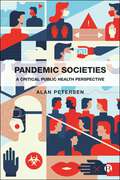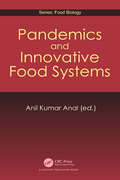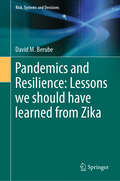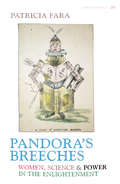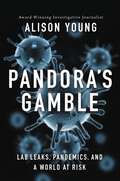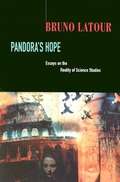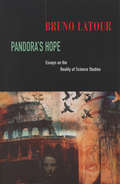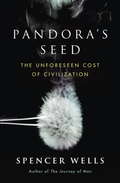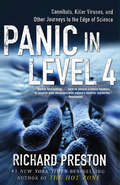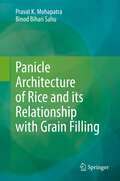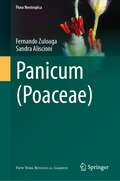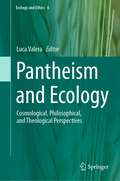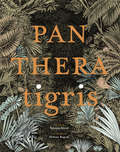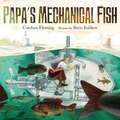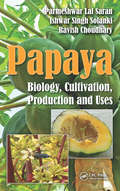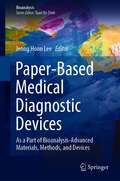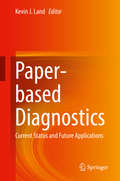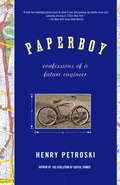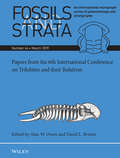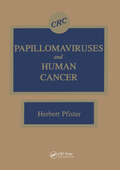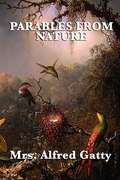- Table View
- List View
Pandemic Societies: A Critical Public Health Perspective
by Alan PetersenFrom SARS to Zika, and Ebola to COVID-19, epidemics and pandemics have become increasingly prevalent in recent years. Each outbreak presents new challenges but the responses are often similar. This important book explores the dimensions, dynamics and implications of emerging pandemic societies. Drawing on ideas from sociology and science and technology studies, it sheds new light on how pandemics are socially produced and, in turn, shape societies in areas such as governance, work and recreation, science and technology, education, and family life. It offers pointers to the future of pandemic societies, including the expansion of technologies of surveillance and control, as well as the prospects of social renewal created by economic and social disruption.
Pandemics and Innovative Food Systems (Food Biology Series)
by Anil Kumar AnalThe debate on health, nutrition and food security could not have arisen at a more opportune time. The recent pandemic has given rise to increased food and nutrition insecurity for individuals, families, and communities. The crisis threatened the food security and nutrition of millions of people, many of whom were already suffering. We face possible disruptions to the functioning of food systems, with severe consequences for health and nutrition. Pandemics create a greater burden for poorer countries and countries since they are already pressure of inadequate food supplies. With concerted action, we can not only avoid some of the worst impacts but do so in a way that supports a transition to more sustainable food systems that are in better balance with nature and that support healthy diets – and thus better health prospects for all. This book aims to highlight the impact of pandemics in food systems and nutrition security. It draws on the experience from the past and present pandemics to better prepare the world for future crises.
Pandemics and Resilience: Lessons we should have learned from Zika (Risk, Systems and Decisions)
by David M. BerubeThe aim of the book was to produce the most comprehensive examination of a pandemic that has ever been attempted. By cataloging the full extent of the Zika pandemic, this book will be the most complete history and epistemic contextualization ever attempted to date. The work should function as the primary source for students, researchers, and scholars who need information about the Zika pandemic. This book examines the technical literature, digital and popular literature, and online materials to fully contextualize this event and provide a bona fide record of this event and its implications for the future. It is somewhat serendipitous that while this work was underway, we are going through another pandemic. One of the primary lessons we did not learn by Zika was pandemic events will return repeatedly, and we need to learn from each one of them to prepare the planet for the next one. Just because Zika seemed to have died out does not make it less important. We were lucky that the virus evolved into what seemed to be a less virulent version of itself, and the vector mosquitoes were concentrated elsewhere. Finally, this book represents a tour de force in scholarship involving nearly 4,000 sources of information and does not shy from a detailed examination of the controversies, conspiracies, and long-term consequences when we avoid learning from outbreaks, such as Zika.
Pandora's Breeches: Women, Science and Power in the Enlightenment
by Patricia Fara'Had God intended Women merely as a finer sort of cattle, he would not have made them reasonable.' Writing in 1673, Bathsua Makin was one of the first women to insist that girls should receive a scientific education. Despite the efforts of Makin and her successors, women were excluded from universities until the end of the nineteenth century, yet they found other ways to participate in scientific projects.Taking a fresh look at history, Pandora's Breeches investigates how women contributed to scientific progress. As well as collaborating in home-based research, women corresponded with internationally-renowned scholars, hired tutors, published their own books and translated and simplified important texts, such as Newton's book on gravity. They played essential roles in work frequently attributed solely to their husbands, fathers or friends.
Pandora's Gamble: Lab Leaks, Pandemics, and a World at Risk
by Alison YoungNamed to Kirkus Reviews&’ Best Books of 2023 A &‘remarkable book.&’ – The New York TimesThis fearless, deeply reported book about laboratory accidents asks the haunting question some elite scientists don&’t want the public to entertain: Did the COVID-19 pandemic start with a lab leak in Wuhan, China? This is an obvious question. Yet there&’s been an extraordinary effort by government officials in China, as well as leading scientific experts in the United States and around the world, to shut down any investigation or discussion of the lab leak theory. In private, however, some of the world&’s elite scientists have seen a lab accident as a very real and horrifying possibility. They know what the public doesn&’t. Lab accidents happen with shocking frequency. Even at the world&’s best-run labs. That&’s among the revelations from Alison Young, the award-winning investigative reporter who has spent nearly 15 years uncovering shocking safety breaches at prestigious U.S. laboratories for USA Today and other respected news outlets. In Pandora&’s Gamble, Young goes deep into the troubling history -- and enormous risks -- of leaks and accidents at scientific labs. She takes readers on a riveting journey around the world to some of the worst lab mishaps in history, including the largely unknown stories of the lab workers at the U.S. Army&’s Camp Detrick who suffered devastating infections at alarming rates during World War II. And her groundbreaking reporting exposes for the first time disturbing new details about recent accidents at prestigious laboratories – and the alarming gaps in government oversight that put all of us at risk. Sourced through meticulous reporting and exclusive interviews with key players including Dr. Anthony Fauci, former CDC Director Tom Frieden and others, Young&’s examination reveals that the only thing rare about lab accidents is the public rarely finds out about them. Because when accidents happen, powerful people and institutions often work hard to keep the information secret.
Pandora's Hope: Essays on the Reality of Science Studies
by Bruno LatourA scientist friend asked Bruno Latour point-blank: "Do you believe in reality?" Taken aback by this strange query, Latour offers his meticulous response in Pandora's Hope. It is a remarkable argument for understanding the reality of science in practical terms. In this book Latour, identified by Richard Rorty as the new "bête noire of the science worshipers," gives us his most philosophically informed book since Science in Action. Through case studies of scientists in the Amazon analyzing soil and in Pasteur's lab studying the fermentation of lactic acid, he shows us the myriad steps by which events in the material world are transformed into items of scientific knowledge. Through many examples in the world of technology, we see how the material and human worlds come together and are reciprocally transformed in this process. Why, Latour asks, did the idea of an independent reality, free of human interaction, emerge in the first place? His answer to this question, harking back to the debates between Might and Right narrated by Plato, points to the real stakes in the so-called science wars: the perplexed submission of ordinary people before the warring forces of claimants to the ultimate truth.
Pandora's Hope: Essays on the Reality of Science Studies
by Bruno LatourA scientist friend asked Bruno Latour point-blank: “Do you believe in reality?” Taken aback by this strange query, Latour offers his meticulous response in Pandora’s Hope. It is a remarkable argument for understanding the reality of science in practical terms. In this book, Latour, identified by Richard Rorty as the new “bête noire of the science worshipers,” gives us his most philosophically informed book since Science in Action. Through case studies of scientists in the Amazon analyzing soil and in Pasteur’s lab studying the fermentation of lactic acid, he shows us the myriad steps by which events in the material world are transformed into items of scientific knowledge. Through many examples in the world of technology, we see how the material and human worlds come together and are reciprocally transformed in this process. Why, Latour asks, did the idea of an independent reality, free of human interaction, emerge in the first place? His answer to this question, harking back to the debates between Might and Right narrated by Plato, points to the real stakes in the so-called science wars: the perplexed submission of ordinary people before the warring forces of claimants to the ultimate truth.
Pandora's Lab: Seven Stories of Science Gone Wrong
by Paul A Offit<p>What happens when ideas presented as science lead us in the wrong direction? <p>History is filled with brilliant ideas that gave rise to disaster, and this book explores the most fascinating--and significant--missteps: from opium's heyday as the pain reliever of choice to recognition of opioids as a major cause of death in the U.S.; from the rise of trans fats as the golden ingredient for tastier, cheaper food to the heart disease epidemic that followed; and from the cries to ban DDT for the sake of the environment to an epidemic-level rise in world malaria. <p>These are today's sins of science--as deplorable as mistaken past ideas about advocating racial purity or using lobotomies as a cure for mental illness. These unwitting errors add up to seven lessons both cautionary and profound, narrated by renowned author and speaker Paul A. Offit. Offit uses these lessons to investigate how we can separate good science from bad, using some of today's most controversial creations--e-cigarettes, GMOs, drug treatments for ADHD--as case studies. For every "Aha!" moment that should have been an "Oh no," this book is an engrossing account of how science has been misused disastrously--and how we can learn to use its power for good.</p>
Pandora's Seed: Why the Hunter-Gatherer Holds the Key to Our Survival
by Spencer WellsTen thousand years ago, our species made a radical shift in its way of life: We became farmers rather than hunter-gatherers. Although this decision propelled us into the modern world, renowned geneticist and anthropologist Spencer Wells demonstrates that such a dramatic change in lifestyle had a downside that we're only now beginning to recognize. Growing grain crops ultimately made humans more sedentary and unhealthy and made the planet more crowded. The expanding population and the need to apportion limited resources created hierarchies and inequalities. Freedom of movement was replaced by a pressure to work that is the forebear of the anxiety millions feel today. Spencer Wells offers a hopeful prescription for altering a life to which we were always ill-suited. Pandora's Seed is an eye-opening book for anyone fascinated by the past and concerned about the future.
Panel Reports--New Worlds, New Horizons in Astronomy and Astrophysics
by National Research Council of the National AcademiesEvery ten years the National Research Council releases a survey of astronomy and astrophysics outlining priorities for the coming decade. The most recent survey, titled New Worlds, New Horizons in Astronomy and Astrophysics, provides overall priorities and recommendations for the field as a whole based on a broad and comprehensive examination of scientific opportunities, infrastructure, and organization in a national and international context. Panel Reports--New Worlds, New Horizons in Astronomy and Astrophysics is a collection of reports, each of which addresses a key sub-area of the field, prepared by specialists in that subarea, and each of which played an important role in setting overall priorities for the field. The collection, published in a single volume, includes the reports of the following panels: Cosmology and Fundamental Physics Galaxies Across Cosmic Time The Galactic Neighborhood Stars and Stellar Evolution Planetary Systems and Star Formation Electromagnetic Observations from Space Optical and Infrared Astronomy from the Ground Particle Astrophysics and Gravitation Radio, Millimeter, and Submillimeter Astronomy from the Ground The Committee for a Decadal Survey of Astronomy and Astrophysics synthesized these reports in the preparation of its prioritized recommendations for the field as a whole. These reports provide additional depth and detail in each of their respective areas. Taken together, they form an essential companion volume to New Worlds, New Horizons: A Decadal Survey of Astronomy and Astrophysics. The book of panel reports will be useful to managers of programs of research in the field of astronomy and astrophysics, the Congressional committees with jurisdiction over the agencies supporting this research, the scientific community, and the public.
Panic in Level 4: Cannibals, Killer Viruses, and Other Journeys to the Edge of Science
by Richard PrestonPanic in Level 4 is a grand tour through the eerie and unforgettable universe of Richard Preston, filled with incredible characters and mysteries that refuse to leave one's mind. Here are dramatic true stories from this acclaimed and award-winning author, including * the phenomenon of "self-cannibals," who suffer from a rare genetic condition caused by one wrong letter in their DNA that forces them to compulsively chew their own flesh--and why everyone may have a touch of this disease * the search for the unknown host of Ebola virus, an organism hidden somewhere in African rain forests, where the disease finds its way into the human species, causing outbreaks of unparalleled horror * the brilliant Russian brothers--"one mathematician divided between two bodies"--who built a supercomputer in their apartment from mail-order parts in an attempt to find hidden order in the number pi (π). In exhilarating detail, Preston portrays the frightening forces and constructive discoveries that are currently roiling and reordering our world, once again proving himself a master of the nonfiction narrative.
Panicle Architecture of Rice and its Relationship with Grain Filling
by Binod Bihari Sahu Pravat K. MohapatraThis book shows the importance of rice for human consumption. It focuses on the rice panicle, its morphology and characteristics. High genetic diversity of rice has been economically profitable for mankind; the crop provides food calories to half of the human race on earth and because of its adaptability to diversified and unstable ecological conditions, the plant has an asynchronous flowering system in the panicle. The International Rice Research Institute has a collection of panicles with numerous branching phenotypes and lengths varying from 10 to 43 cm. Due to the heterogeneous architecture, grain filling depends on the position of the spikelet within a panicle. Spikelets on apical branches fertilize early and fill faster compared to their basal counterparts and therefore, individual grain weights of panicle vary widely. The discrepancy in grain filling between spikelets changes with panicle architecture but the relationship of variation in individual grain weight with panicle architecture has not been studied. Spikelet number has increased highly in the newly developed rice cultivars, but it has no benefit accrued on grain filling and yield. This book is recommended for students, researchers and teachers working in this field of expertise.
Panicum (Flora Neotropica #124)
by Fernando Zuloaga Sandra AliscioniThis work will be volume 124 in the Flora Neotropica Monograph book Series, Lawrence M. Kelly (Editor-in-Chief). Flora Neotropica volumes provide taxonomic treatments of plant groups or families growing in the Americas between the Tropic of Cancer and the Tropic of Capricorn. This monograph on Panicum (Poaceae), known as panicgrass, was written by the world-leading authority on this plant group. A total of one genus and 63 species are described. It also includes information on conservation, phylogenetic relationships, taxonomic history, ecology, cytology, and anatomy, among other topics. This is the first comprehensive volume on this topic since the 1920s and is lavishly illustrated with line drawings, black and white photographs, and distribution maps.
Pantheism and Ecology: Cosmological, Philosophical, and Theological Perspectives (Ecology and Ethics #6)
by Luca ValeraThis book provides a comprehensive overview of the relationship between pantheism and ecology, particularly considering different cultural approaches and diverse religious, theological, and philosophical traditions. Environmental ethics arises from the dangerousness and harmfulness of human beings with respect to nonhuman species and, more generally, with respect to the environment. A common starting point for environmental ethics standpoints is that human beings are responsible for damaging nature. The famous four laws of ecology drafted by Barry Commoner precisely express this guilt on the part of human beings, who very often voluntarily violate the behavioral indications that emerge from nature itself. These aspects concern environmental ethics outlooks. Eco-theology, then, takes a further step: not only do we damage the ecosystem but also, as many authors suggest, when we humans destroy the natural world, we are wounding God. Such an idea implies a possible coincidence of God with the natural world –or the ecosystem. From this assumption, different questions may emerge: what is the kind of coincidence between God and the natural world? Are God and the ecosystem coextensive? If so, are we re-sacralizing the natural world and grounding intrinsic values in theological postulates and statements? These questions lead us to reconsider the cosmological assumptions that ground our environmental judgements, from theology to different religious traditions and cultures to philosophical worldviews. In particular, we will focus on the cosmological assumptions of pantheism (considering its differences with panentheism), discussing the symmetrical (or asymmetrical) relationships between God and the finite ways in which God manifests Godself.In this regard, the book is divided into three main parts: in the first part, the question of pantheism is approached from different traditions and with a special focus on the main thinkers in the history of thought, from Greek Stoicism to the present day. In the second part, some current ecological concerns are considered in relation to pantheistic cosmology: the authors will deepen issues from the discussion of the different “pan-conceptions” to the problem of evil, to Anthropocene. Finally, in the third part, the different chapters will focus on ethical issues in the field of the current environmental crisis with a huge connection with the pantheistic cosmologies. This book is oriented to a wide public, interested in environmental issues and looking for an approach from different cultures and traditions. Evidently, due to its “academic” nature, this book is also intended to be a great support for researchers interested in eco-theology and, more specifically, in the relationship between pantheism and ecology.It is not, in this sense, a “classic” book on environmental ethics, but a book that delves into the fundamentals of environmental philosophy, privileging the Ibero-American approach.
Panthera Tigris
by Sylvain AlzialWhile reading an encyclopedia, a highly educated scientist realizes that he doesn&’t know anything about tigers! He begins studying them until he can rattle off every tiger fact imaginable, including their habitat (jungles and marshy areas), their average weight (300-500 pounds), and their scientific name (Panthera tigris). But when he hires a guide to take him to see a tiger in person, the scientist discovers that he might not quite know everything.With deadpan humor and illustrations that perfectly complement the story, Panthera Tigris will delight nature lovers and budding scientists.
Papa's Mechanical Fish
by Candace Fleming Boris KulikovClink! Clankety-bang! Thump-whirr! That's the sound of Papa at work. Although he is an inventor, he has never made anything that works perfectly, and that's because he hasn't yet found a truly fantastic idea. But when he takes his family fishing on Lake Michigan, his daughter Virena asks, "Have you ever wondered what it's like to be a fish?"―and Papa is off to his workshop. With a lot of persistence and a little bit of help, Papa―who is based on the real-life inventor Lodner Phillips―creates a submarine that can take his family for a trip to the bottom of Lake Michigan.
Papa's Mechanical Fish
by Candace FlemingCandace Fleming and illustrator Boris Kulikov pair up to tell a fun story about a real submarine inventor in Papa's Mechanical FishClink! Clankety-bang! Thump-whirr! That's the sound of Papa at work. Although he is an inventor, he has never made anything that works perfectly, and that's because he hasn't yet found a truly fantastic idea. But when he takes his family fishing on Lake Michigan, his daughter Virena asks, "Have you ever wondered what it's like to be a fish?"—and Papa is off to his workshop. With a lot of persistence and a little bit of help, Papa—who is based on the real-life inventor Lodner Phillips—creates a submarine that can take his family for a trip to the bottom of Lake Michigan.
Papaya: Biology, Cultivation, Production and Uses
by Parmeshwar Lal Saran Ishwar Singh Solanki Ravish ChoudharyWith coverage that ranges from basic information to advanced research, Papaya: Biology, Cultivation, Production and Uses pulls together the vast literature scattered over various sources into one practical resource. The book provides a solid review of papaya biology, production, and uses supported by color photographs and illustrations. It covers p
Paper Microfluidics: Theory and Applications (Advanced Functional Materials and Sensors)
by Sanjay Kumar Shantanu Bhattacharya Avinash K. AgarwalThis volume provides an overview of the recent advances in the field of paper microfluidics, whose innumerable research domains have stimulated considerable efforts to the development of rapid, cost-effective and simplified point-of-care diagnostic systems. The book is divided into three parts viz. theoretical background of paper microfluidics, fabrication techniques for paper-based devices, and broad applications. Each chapter of the book is self-explanatory and focuses on a specific topic and its relation to paper microfluidics and starts with a brief description of the topic’s physical background, essential definitions, and a short story of the recent progress in the relevant field. The book also covers the future outlook, remaining challenges, and emerging opportunities. This book shall be a tremendous up-to-date resource for researchers working in the area globally.
Paper-Based Medical Diagnostic Devices: As a Part of Bioanalysis-Advanced Materials, Methods, and Devices (Bioanalysis #10)
by Jeong Hoon LeeThis book disseminates information on paper-based diagnostics devices and describes novel paper materials, fabrication techniques, and Basic Paper-based microfluidics/electronics theory. The section on sample preparation, paper-based electronics/sensors for developing paper-based point-of-care (POC) systems also contains detailed descriptions. In the application sections this book covers sensing technique for DNA/RNA, bacteria/virus and integration of lateral flow assay. The book provides deep understanding and knowledge of paper-based diagnostic device development in terms of concept, materials, fabrication and applications.
Paper-based Diagnostics
by Kevin J. LandThis book explores the status of paper-based diagnostic solutions, or Microfluidics 2.0. The contributors explore: how paper-based tests can be widely distributed and utilized by semi-skilled personnel; how close to commercial applications the technology has become, and what is still required to make paper-based diagnostics the game-changer it can be. The technology is examined through the lens of the World Health Organization’s ASSURED criteria for low-resource countries (Affordable, Sensitive, Specific, User-friendly, Rapid and robust, Equipment-free, and Deliverable to end-users). Its applications have to include: health technology, environmental technology, food safety, and more. This book is appropriate for researchers in these areas, as well as those interested in microfluidics, and includes chapters dedicated to principles such as theory of flow and surface treatments; components such as biomarkers and detection; and current methods of manufacturing. Discusses how paper-based diagnostics can be used in developing countries by comparing current diagnostic tests with the World Health Organization's ASSURED criteriaExamines how paper-based diagnostics could be integrated with other technologies, such as printed electronics, and the Internet of Things.Outlines how semi-skilled personnel across a variety of fields can implement paper-based diagnostics
Paperboy: Confessions of a Future Engineer
by Henry PetroskiHenry Petroski has been called "the poet laureate of technology." He is one of the most eloquent and inquisitive science and engineering writers of our time, illuminating with new clarity such familiar objects as pencils, books, and bridges. In Paperboy, he turns his intellectual curiosity inward, on his own past. Petroski grew up in the Cambria Heights section of New York City's borough of Queens during the 1950s, in the midst of a close and loving family. Educated at local Catholic schools, he worked as a delivery boy for the Long Island Press. The job taught him lessons about diligence, labor, commitment, and community-mindedness, lessons that this successful student could not learn at school. From his vantage point as a professor, engineer, and writer, Petroski reflects fondly on these lessons, and on his near-idyllic boyhood. Paperboy is also the story of the intellectual maturation of an engineer. Petroski's curiosity about how things work--from bicycles to Press-books to newspaper delivery routes--was evident even in his youth. He writes with clear-eyed passion about the physical surroundings of his world, the same attitude he has brought to examining the quotidian objects of our world. Paperboy is a delightful memoir, telling the dual story of an admirable family in a more innocent, bygone America, and the making of an engineer and writer. This is a book to cherish and reread.
Papers from the 6th International Conference on Trilobites and their Relatives (Fossils and Strata Monograph Series #64)
by David L. Bruton Alan W. OwenA volume from a monograph series featuring seven papers on trilobites with brief summariesThis research volume is entitled Papers from the 6th International Conference on Trilobites and their Relatives. It's Volume 64 within the Fossils and Strata monograph series. The research compilation originated from a 2017 conference in Estonia. Seven papers on trilobites are included with summaries in the publication. The papers' topics cover trilobites from the Early Cambrian to the Late Devonian.
Papillomaviruses and Human Cancer
by Herbert PfisterThis volume gives special reference to papillomaviruses in benign precursor lesions related to genital tumors, plus it provides a basis for a more reproducible evaluation of the pathology of papillomavirus-induced lesions. It deals with the molecular biology of papillomaviruses as it relates to our understanding of viral cell transformation and malignant conversion. Written in a comprehensive, easy-to-read format, this book covers points of medical interest such as diagnosis, therapy, and prospects for vaccination. This fascinating text provides current, state-of-the-art practices for immediate and future medical research. Virologists, microbiologists, and cancer researchers will find this work interesting and resourceful.
Parables from Nature
by Mrs Alfred GattyCollected here are twenty nine stories, originally published as four separate volumes. Parables From Nature are inspired from nature, but written in a fun and entertaining way for children to be able to read, understand, and enjoy!
